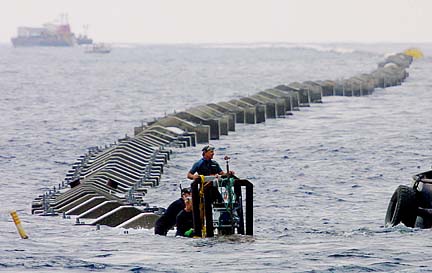


|
A new 55-inch diameter pipeline system that was 12 years in planning, design and construction is expected to spur development at the Hawaii Ocean Science and Technology Park on the Big Island. Pipeline nourishes
ocean tech parkOfficials hope the new source
for nutrient-rich sea water will
attract tenants to the Big IsleBy Helen Altonn
haltonn@starbulletin.comThe deep-water pipeline extends to a depth of 3,000 feet, 9,700 feet offshore of the Natural Energy Laboratory of Hawaii Authority's HOST Park. It was built at Kawaihae Harbor, about 27 miles north of Keahole Point, by NELHA's prime contractor, Healy Tibbitts Builders Inc. Installation was completed in November.
Makai Ocean Engineering Inc. of Waimanalo designed the system in 1989 to supply up to 27,000 gallons a minute of cold, clean, nutrient-rich, deep-sea water to the commercial tenants of the 547-acre park.
Tom Daniel, NELHA scientific/technical program manager, said the new system "is the culmination of a 12-year period of patient planning, lobbying, designing and negotiating."
The 55-inch diameter of the pipe was deemed appropriate for the mix of aquaculture and other uses in the park, as well as a conventional ocean thermal energy conversion plant, he said.
Efforts to obtain funding began with $500,000 from the state Legislature for the final design in 1992. After NELHA tried for several years to obtain more funding, the 1999 Legislature approved $16 million in capital improvement funds for the present two-year budget.
Lawmakers appropriated another $1.6 million last year to complete the water delivery system.
Daniel said impetus for completion of the pipeline came from several existing and potential NELHA tenants, primarily the Big Island Abalone Corp., which began building a 60-acre abalone farm in the HOST Park in June 2000.
Interim sea-water systems supply the company with almost 3,000 gallons a minute of deep-sea water and 1,300 gallons a minute of surface sea water, Daniel said.
He said the company expects to use more than half of the total capacity of the new deep-water pipeline system by 2005.
Other HOST Park tenants planning to draw water from the new pipeline, he said, are the Oceanic Institute, which is preparing to build a Finfish Research and Technology Demonstration Project and a public outreach and demonstration facility; Marine BioProducts Inc. of Canada, preparing to develop algae-growing facilities for production of specialty agar products; and Moana Technologies Inc., which is developing a shrimp broodstock production facility.
He said other major users will include:
>> NELHA's Gateway Project, an alternative energy research, development and deployment site to be located at the entrance to the laboratory properties. Daniel said $3 million in federal money has been appropriated for the construction, and additional funds are being appropriated for the program, which will allow expansion of the laboratory's alternative-energy research projects.He said the Kalina cycle using the 55-inch pipeline will dramatically increase the electrical output and enhance the future of OTEC.>> The authority also is seeking proposals for a 75-acre "Ocean Centerpiece Project" that will include various ocean-related activities that will incorporate the area's unique ocean resources.
>> A consortium has approached NELHA with a proposal to build a Kalina cycle Ocean Thermal Energy Conversion plant using the new system. Daniel said the Kalina cycle "is an exciting new technology developed by Dr. Alexander Kalina, a Russian emigre to California, that makes the OTEC process more efficient than previously used (traditional) technologies."
OTEC's plant uses NELHA's resources to produce clean, renewable energy by utilizing heat energy stored in the ocean. It uses the difference in temperature between warm surface sea water and cold deep-sea water to produce electricity.
Discussions are continuing with the consortium and others about possible OTEC projects using sea water delivered by the new pipelines, he said.
The facility also is attracting many other "new and leading-edge ideas," Daniel said. "It is these steady pioneering efforts that allow NELHA to fulfill its mandate to develop and diversify Hawaii's economy."